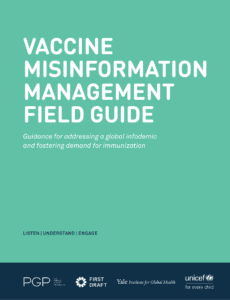Misinformation Alerts
Knowing what misinformation is being shared can help you generate effective messaging.
These insights are based on a combination of automated media monitoring and manual review by public health data analysts. Media data are publicly available data from many sources, such as social media, broadcast television, newspapers and magazines, news websites, online video, blogs, and more. Analysts from the Public Good Projects triangulate this data along with other data from fact checking organizations and investigative sources to provide an accurate, but not exhaustive, list of currently circulating misinformation.
Misinformation Alerts
Knowing what misinformation is being shared can help you generate effective messaging.
These insights are based on a combination of automated media monitoring and manual review by public health data analysts. Media data are publicly available data from many sources, such as social media, broadcast television, newspapers and magazines, news websites, online video, blogs, and more. Analysts from the Public Good Projects triangulate this data along with other data from fact checking organizations and investigative sources to provide an accurate, but not exhaustive, list of currently circulating misinformation.Alerts are categorized as high, medium, and low risk.
- High risk alerts: Narratives with widespread circulation across communities, high engagement, exponential velocity, and a high potential to impact health decisions. Are often more memorable than accurate information.
- Medium risk alerts: Narratives that are circulating in priority populations and pose some threat to health. Potential for further spread due to the tactics used or because of predicted velocity. Often highlights the questions and concerns of people.
- Low risk alerts: Narratives that are limited in reach, don’t impact your community, or lack the qualities necessary for future spread. May indicate information gaps, confusion, or concerns.
A conspiracy news site published an article falsely claiming that the CDC is cross-checking census data and vaccination records to identify and target unvaccinated people. While local and federal government initiatives have focused vaccine outreach to specific areas and populations with low vaccination rates, individuals are not being targeted by any health officials.
Recommendation: There is widespread confusion and potential suspicion related to government initiatives in low vaccination areas. Emphasizing the work of local, trusted messengers to encourage vaccination in communities is recommended. Fact Checking Source(s): PolitiFact: No, health officials aren't using Census data to target unvaccinated people 
Several social media accounts with large followings have shared the preprint of a study that claims teen boys are at greater myocarditis (heart inflammation) risk from vaccination than COVID-19 infection. The study, which is still under peer review, has been heavily criticized by physicians and public health experts who noted that it relies entirely on a search for potential myocarditis-related symptoms in unverified VAERS reports. The study’s authors flagged every VAERS report of high levels of the heart protein troponin as “myocarditis.” Cardiologists were quick to point out that equating high troponin with myocarditis is grossly inaccurate as the protein can increase in response to many regular activities, including exercise. The study also does not directly compare myocarditis following vaccination and COVID-19 infection; it compares VAERS reports that may be related to myocarditis in young men to COVID-19 hospitalization for the same age group. The study failed to correct for the baseline level of myocarditis in the age group and ignored that their risk of developing myocarditis from a COVID-19 infection is seven times higher than from COVID-19 vaccination.
Recommendation: The limited number of cases of heart inflammation in teens and young adults following COVID-19 vaccination has caused widespread concern and information seeking. Organizations are recommended to directly address this understandable concern and to update informational and educational materials accordingly. Fact Checking Source(s): Your Local Epidemiologist, Science-Based Medicine, New Scientist
A social media post that claims to offer tips from a nurse to treat COVID-19 at home suggests everything from taking daily supplements and baby aspirin to sleeping on your stomach and drinking berry smoothies. None of the proposed remedies are supported by any evidence but most are relatively harmless. Dietary supplements and daily aspirin regimens should not be started without first consulting a doctor.
Recommendation: While addressing each piece of misinformation can detract from priority talking points, false claims promoting “natural” COVID-19 remedies continue to proliferate. Informational and educational resources are recommended to address existing approved treatments for COVID-19, as well as to refute and debunk widely reported unapproved treatments and cures. Fact Checking Source(s): AFP
A pop star made headlines after telling her fans on social media not to be “bullied” into getting the COVID-19 vaccine and claiming that her cousin’s friend in Trinidad developed swollen testicles and became impotent after getting vaccinated. Trinidad's health minister has said that no such post-vaccination adverse events have been reported in the country. Although the singer’s claim was quickly debunked by doctors who noted that there is no evidence that the vaccine affects fertility or erectile function, the incident highlights the pervasiveness of some of the most persistent COVID-19 vaccine myths.
Recommendation: Because the singer has such a large following, misinformation around vaccines and fertility issues has spread quickly. Ensuring that educational materials address fertility concerns is recommended. Fact Checking Source(s): AFP, Politifact, Factcheck.org 
A social media post is claiming that in November all Walmart locations will begin requiring customers to provide proof of COVID-19 vaccination. A Walmart spokesperson said this claim is false. The company is requiring employees at some US locations to get vaccinated but no vaccine requirement exists for customers. Online misinformation related to vaccine mandates and vaccine passports has spiked in the days since the federal government announced vaccination or testing requirements for large employers.
Recommendation: Confusion and misinformation about President Biden’s latest plan to curb the pandemic is widespread. In particular, there is rampant confusion over the federal vaccine mandates, to whom they apply, and when they will be enacted. Updating educational and informational materials to explain the vaccine mandates is recommended. Helpful talking points are available here. Fact Checking Source(s): Lead Stories
Multiple social media accounts are circulating the myth that Dr. Christine Grady, wife of NIAID Director Dr. Anthony Fauci, is the head of the FDA and was responsible for approving the Pfizer-BioNTech vaccine. Dr. Grady is the chief of bioethics at the NIH Clinical Center, which plays no role in the emergency use authorization or approval of any drugs or vaccines.
Recommendation: 
The results of an Oxford study currently under peer review have been misinterpreted online to suggest that vaccinated patients with COVID-19 have 251 times the viral load of unvaccinated patients. The false claim, which the study’s author called "an egregious misinterpretation of the findings," has been widely shared by individuals and organizations previously shown to spread anti-vaccine rhetoric. The purpose of the study was to examine breakthrough infections in health care workers and compare viral loads between those individuals infected with the Delta variant and patients infected with the original COVID-19 viral strain. The study did not compare viral load in individuals based on vaccination status. The researchers found significantly higher viral loads in Delta infections than in those with the original COVID-19 strain.
Recommendation: Reports of breakthrough cases continue to fuel vaccine misinformation. Explaining that breakthrough cases are expected, uncommon, and are only occurring due to the highly transmissible Delta variant is recommended. Emphasizing that the COVID-19 vaccines still protect against severe diseases, hospitalization, and death is also recommended. Fact Checking Source(s): AFP
Several news outlets and social media accounts have falsely claimed that ivermectin has been approved to treat COVID-19 in Japan. One video that has been viewed more than 80,000 times claims to show the chair of the Tokyo Medical Association recommending ivermectin for all COVID-19 patients. In the video, he discusses ivermectin’s apparent benefits and suggests the off-label prescription of the drug. He also acknowledges that more study of the drug is necessary. The chair and his organization are not part of Japan’s Health Ministry, which oversees drug approvals and provides official health guidance. Ivermectin is not among the drugs approved for use against COVID-19 in Japan and neither the Tokyo government nor the Japanese Health Ministry recommends the drug to treat COVID-19. The video has also been widely shared in North America without this context.
Recommendation: Informational and educational resources are recommended to address existing approved treatments for COVID-19, as well as to refute and debunk widely reported unapproved treatments and cures. As speculation regarding the use of ivermectin for treatment of COVID-19 is widespread, explaining the current state of evidence and official guidance in such materials is recommended Fact Checking Source(s): AFP; Tech ARP
An unverified VAERS report that has resurfaced several times since March claims that a breastfeeding baby died suddenly after the mother received a COVID-19 vaccine. The report claims that the mother was vaccinated on March 17 and the baby developed a fever and rash and died the following day. Elsewhere in the report, the vaccination and baby’s death are said to have taken place in March 2020, before any COVID-19 vaccines were available. At least one person who has circulated the claim on social media admitted to using a picture of a child with a rash who is perfectly healthy now. Some who have shared the claims have speculated that the vaccine spike protein could have transferred through the breast milk to cause the alleged symptoms. The spike proteins induced by the mRNA vaccines are harmless; they only serve to train the immune system to recognize the spike protein on the real virus and combat it. All available evidence suggests that the COVID-19 vaccines are safe during both pregnancy and breastfeeding.
Recommendation: There is continuing confusion regarding the impact of COVID-19 vaccines on fertility and reproductive systems. There is also widespread misinformation about spike proteins and mRNA vaccines. Ensuring information and educational materials address these claims is recommended. Fact Checking Source(s): USA Today; CDC; MU Health
A 2018 article about the possibility that viruses can evolve to evade vaccines is trending on social media. The article was shared online by the self-declared “inventor” of mRNA vaccines, who is a vocal opponent of COVID-19 vaccination, in a post claiming that COVID-19 vaccines are creating new variants. The post received nearly 19,000 engagements. While the article, which was published more than a year before SARS-CoV-2 was identified, argues that vaccine-driven evolution of viruses may be possible, there is no evidence that SARS-CoV-2 has evolved in this way. New COVID-19 variants develop when mutations occur during viral replication. Viruses can’t replicate outside of a host—in this case, human cells—so preventing a virus from infecting cells in the first place prevents it from reproducing and mutating.
Recommendation: How viruses evolve to create new variants continues to be a confusing topic for the public. Emphasizing that widespread vaccination and indoor masking are our best way to stop new variants from forming is recommended. Fact Checking Source(s): Reuters; Johns Hopkins; CDC
Alerts are categorized as high, medium, and low risk.
- High risk alerts: Narratives with widespread circulation across communities, high engagement, exponential velocity, and a high potential to impact health decisions. Are often more memorable than accurate information.
- Medium risk alerts: Narratives that are circulating in priority populations and pose some threat to health. Potential for further spread due to the tactics used or because of predicted velocity. Often highlights the questions and concerns of people.
- Low risk alerts: Narratives that are limited in reach, don’t impact your community, or lack the qualities necessary for future spread. May indicate information gaps, confusion, or concerns.
Vaccine Misinformation Guide
Get practical tips for addressing misinformation in this new guide. Click image to download, or see highlights.

